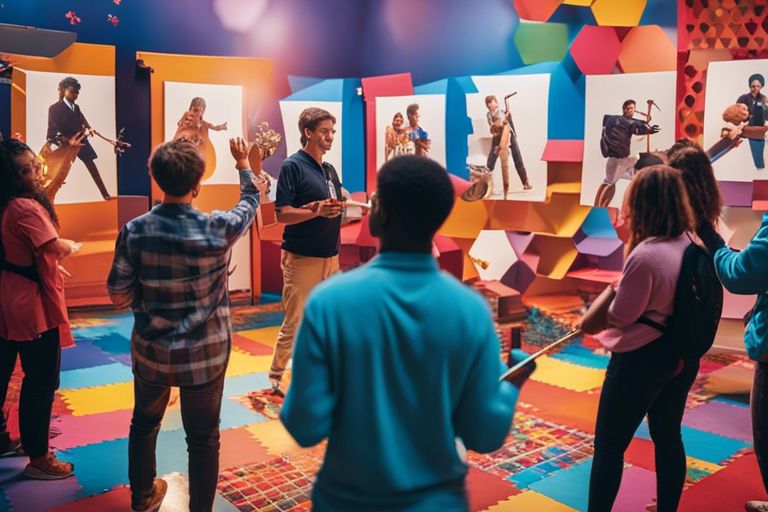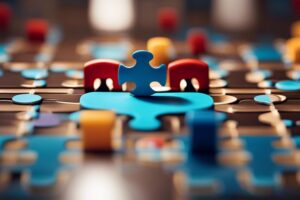Autism is a complex neurological condition that affects individuals in various ways, often leading to difficulties in social interactions and communication. However, what many may not be aware of is the remarkable creativity and artistic talents that can be harnessed in individuals with autism. This blog post probes into the fascinating connection between autism and creativity, shedding light on how individuals on the autism spectrum can excel in various art forms such as painting, music, and writing. By understanding and embracing these unique abilities, we can empower individuals with autism to express themselves and contribute positively to the world through their extraordinary artistic talents.
Key Takeaways:
- Autistic individuals can possess unique artistic talents: Many individuals on the autism spectrum demonstrate exceptional creative abilities, including in areas such as visual arts, music, writing, and more.
- Art therapy can be a beneficial tool: Engaging in art therapy can help individuals with autism explore and express their emotions, improve communication skills, reduce anxiety, and enhance overall well-being.
- Society should embrace and support autistic artists: By recognising and nurturing the artistic talents of individuals with autism, we can create a more inclusive and diverse cultural landscape, promoting acceptance and appreciation for neurodiversity.

The Nature of Creativity
Defining Creativity
Creativity is a complex and multifaceted phenomenon that encompasses a wide range of activities, from artistic expression to problem-solving. It involves the generation of novel ideas, concepts, or solutions that are original and valuable. Creativity is not limited to the arts but permeates every aspect of human endeavour, driving innovation and progress in various fields.
Defining creativity can be challenging due to its subjective nature, as what may be considered creative to one person may not be viewed the same way by another. However, at its core, creativity involves a combination of imagination, originality, and expression that leads to the creation of something new and meaningful.
Neurodiversity and Divergent Thinking
Neurodiversity refers to the diversity of human brains and minds, encompassing individuals with various neurological differences, including autism. Divergent thinking is a cognitive process that involves generating multiple ideas or solutions to a problem, often exploring unconventional or unexpected pathways. People with autism are known to exhibit divergent thinking, which can fuel their creativity and unique perspectives.
Neurodiverse individuals bring a valuable dimension to the creative process through their divergent thinking abilities, which can lead to innovative breakthroughs and original artistic expressions. Their atypical cognitive patterns and sensory experiences offer fresh insights into familiar topics, challenging traditional norms and inspiring new approaches to creativity.
Autistic individuals may perceive the world in ways that differ from neurotypical individuals, allowing them to offer fresh and unconventional perspectives in their creative endeavours. Their unique thought processes and sensory sensitivities can lead to innovative and thought-provoking creations that enrich the creative landscape.

Autism and Artistic Expression
Artistic expression plays a significant role in the lives of individuals on the autism spectrum. Many autistic individuals have unique perspectives and a deep connection to various art forms, showcasing their talents and creativity in remarkable ways. Exploring the relationship between autism and artistic expression sheds light on how creativity can be harnessed as a powerful tool for self-expression and communication.
The Spectrum of Art Forms
Autistic individuals often excel in a wide range of art forms, including painting, sculpture, music, dance, and writing. Each art form provides a unique outlet for self-expression and allows individuals on the spectrum to communicate their thoughts, emotions, and experiences in a way that feels comfortable for them. Some artists with autism have a remarkable attention to detail and a keen eye for beauty and composition, contributing to their distinctive artistic styles.
Furthermore, the diversity and complexity of artistic expressions by individuals on the autism spectrum challenge societal stereotypes and highlight the richness and versatility of their creative talents. Embracing this diversity not only promotes inclusivity in the art world but also encourages a deeper understanding and appreciation for the unique perspectives of autistic artists.
Challenges and Triumphs in Artistic Endeavors
While artistic expression can be a fulfilling and enriching experience for individuals with autism, it also comes with its unique set of challenges. Sensory sensitivities, communication difficulties, and social interactions can present hurdles for autistic artists. However, through patience, support, and understanding, many individuals on the spectrum have overcome these challenges and flourished in their artistic endeavours.
Autistic artists often demonstrate remarkable resilience and determination in pursuing their creative passions, overcoming obstacles that may have once seemed insurmountable. Their triumphs serve as powerful reminders of the transformative power of art and the extraordinary capabilities of individuals with autism when provided with the right support and opportunities.
Strategies for Encouraging Creativity
Educational Approaches
When it comes to nurturing creativity in individuals on the autism spectrum, educational approaches play a crucial role. It is important to implement specialised teaching methods that cater to the unique learning styles and strengths of each individual. Tailoring educational plans to embrace neurodiversity can help unlock the creative potential within each person. To probe deeper into the connection between autism and creativity, check out Creativity Explained: How Neurodiversity Can Fuel the Arts for insightful perspectives.
Therapeutic Modalities
Therapeutic modalities can be powerful tools for fostering creativity in individuals with autism. Art therapy, music therapy, and sensory integration activities are just a few examples of how creative expression can be used as a means of communication and self-discovery. These modalities provide individuals with a safe and supportive environment to explore their thoughts, emotions, and abilities. By engaging in therapeutic creative outlets, individuals can enhance their self-esteem and develop new skills.
Moreover, therapeutic modalities not only promote creativity but also aid in emotional regulation and improve sensory processing in individuals with autism. The sensory-rich experiences offered by creative therapies can help individuals better understand and manage their emotions, leading to improved overall well-being and enhanced quality of life.

Real-life Implications and Societal Impact
As we examine into the realm of autism and creativity, it becomes evident that the artistic talents of individuals on the spectrum have tangible effects on society. Understanding the real-life implications of harnessing these talents is crucial for creating a more inclusive and diverse environment.
Successful Autistic Artists
Many autistic individuals have excelled in the field of art, showcasing unique perspectives and exceptional creativity. Artists such as Stephen Wiltshire, known for his intricate cityscapes, and Jessica Park, famous for her vibrant and emotive paintings, are prime examples of successful autistic artists making a significant impact in the art world.
These artists challenge traditional notions of artistry and provoke thought with their unconventional styles. Their work not only inspires admiration but also serves as a powerful reminder of the depth and richness of the autistic experience.
The Role of Community and Support Networks
Community and support networks play a vital role in nurturing the artistic talents of individuals on the autism spectrum. These networks provide a platform for artists to showcase their work, connect with like-minded individuals, and receive the encouragement and feedback necessary for their artistic growth.
By fostering a sense of belonging and understanding, these networks empower autistic artists to express themselves authentically and contribute meaningfully to the artistic community. The support and camaraderie found within these networks not only boost individual confidence but also pave the way for greater societal acceptance and appreciation of neurodiversity.
The success of autistic artists is not just a personal achievement but a testament to the power of community support and inclusion in cultivating creativity and artistic excellence. By recognising and celebrating the talents of individuals on the autism spectrum, society can embrace a more diverse and enriched cultural landscape.
Final Thoughts
As we conclude our exploration of autism and creativity, it is evident that individuals on the autism spectrum possess remarkable artistic talents that deserve to be nurtured and celebrated. By understanding and embracing the unique perspectives and abilities of autistic individuals, we can create a more inclusive and diverse society that appreciates the richness they bring to the artistic world.
Reframing Perspectives on Autism and Creativity
It is crucial to rethink traditional views on autism and creativity. Instead of seeing autism as a limitation, we should embrace it as a different way of experiencing the world. By reframing our perspectives, we can unlock the untapped potential of individuals on the spectrum and encourage their creative expression without imposing conventional norms.
Future Directions in Research and Practice
Looking ahead, future research and practices should focus on further exploring the intersection of autism and creativity. By delving deeper into how the autistic mind processes art and innovation, we can uncover new insights that may benefit both individuals with autism and the broader creative community.
In addition to enhancing our understanding of autism and creativity, future research and practice should emphasise the importance of providing support and opportunities for autistic individuals to flourish in their artistic endeavours. By creating inclusive environments that celebrate diversity, we can empower individuals on the spectrum to reach their full potential as artists and innovators.
FAQ
Q: What is autism?
A: Autism is a neurodevelopmental disorder that affects communication, social interaction, and behaviour.
Q: How prevalent is autism?
A: Autism affects approximately 1 in 100 people in the UK, according to the National Autistic Society.
Q: What is creativity?
A: Creativity is the ability to generate new ideas, concepts, or associations that are original and valuable.
Q: How is autism related to creativity?
A: Many individuals with autism display exceptional creativity, often in the form of artistic talents such as painting, music, or writing.
Q: How can artistic talents be harnessed in individuals with autism?
A: Art therapy, structured creative activities, and supportive environments can help individuals with autism explore and develop their artistic talents.
Q: What are the benefits of harnessing artistic talents in individuals with autism?
A: Harnessing artistic talents can help individuals with autism improve their communication skills, boost self-esteem, and provide a means of self-expression.
Q: How can society support and promote the creative abilities of individuals with autism?
A: Society can support and promote the creative abilities of individuals with autism by providing inclusive opportunities for artistic expression, fostering acceptance, and celebrating diversity.







